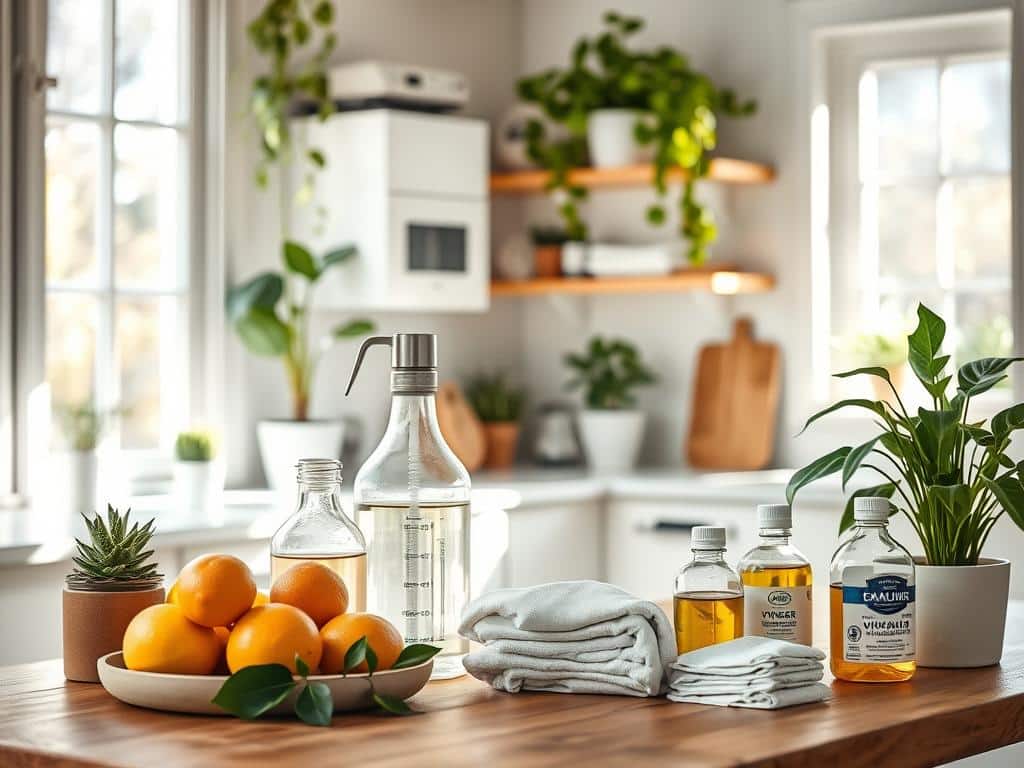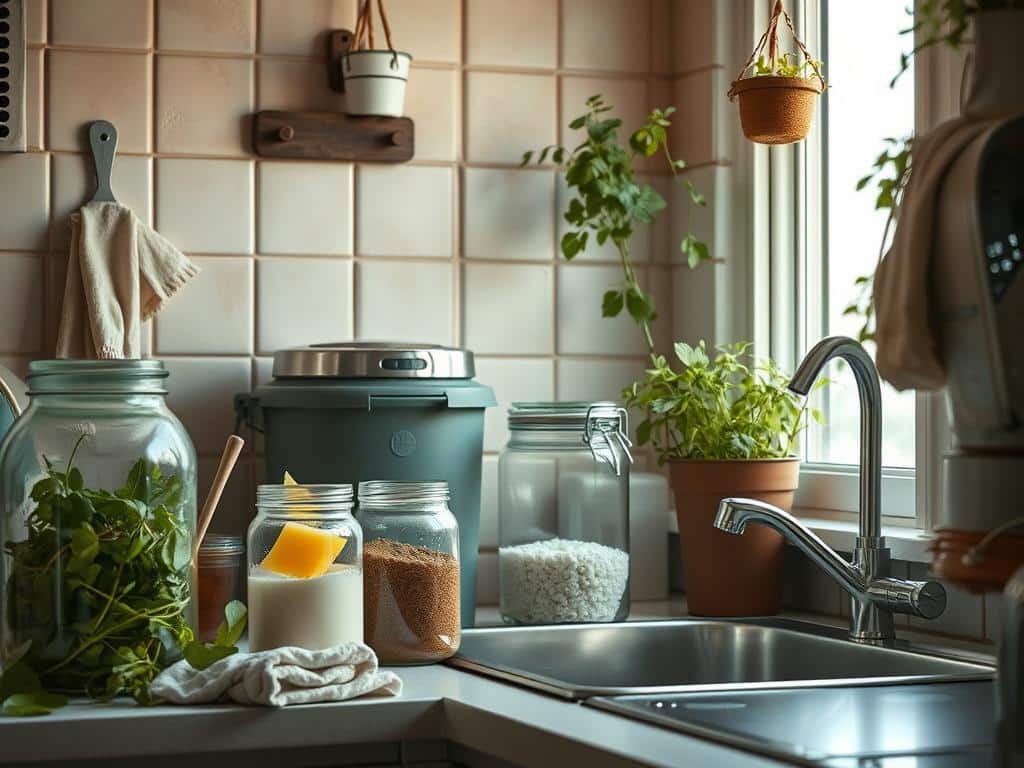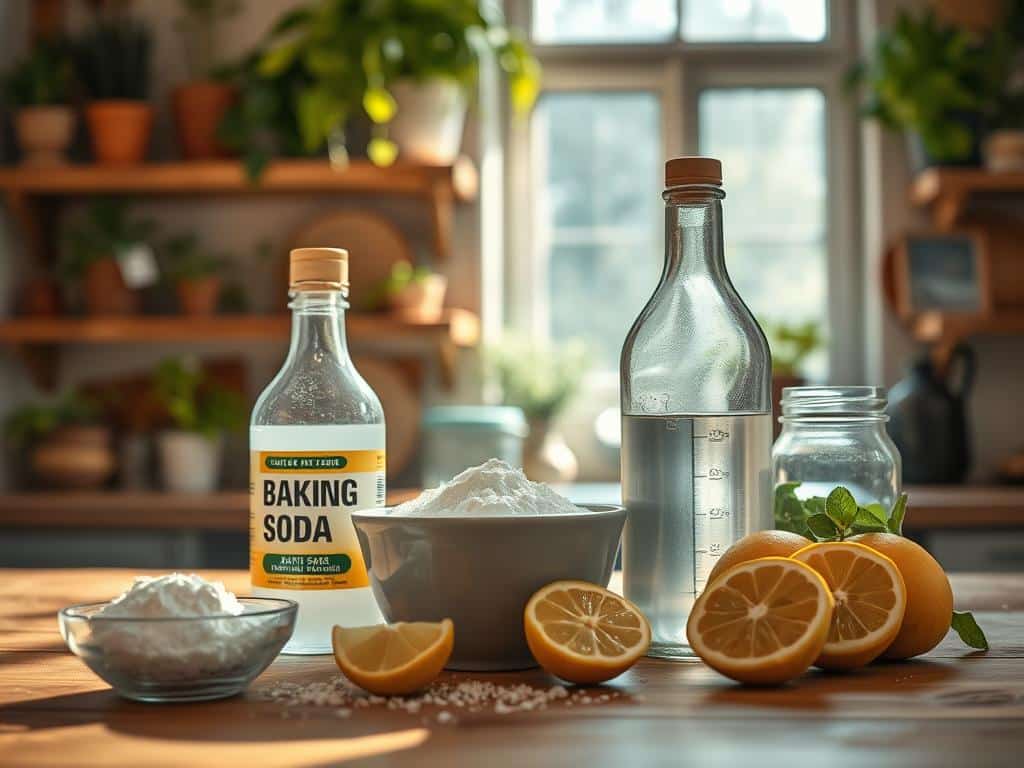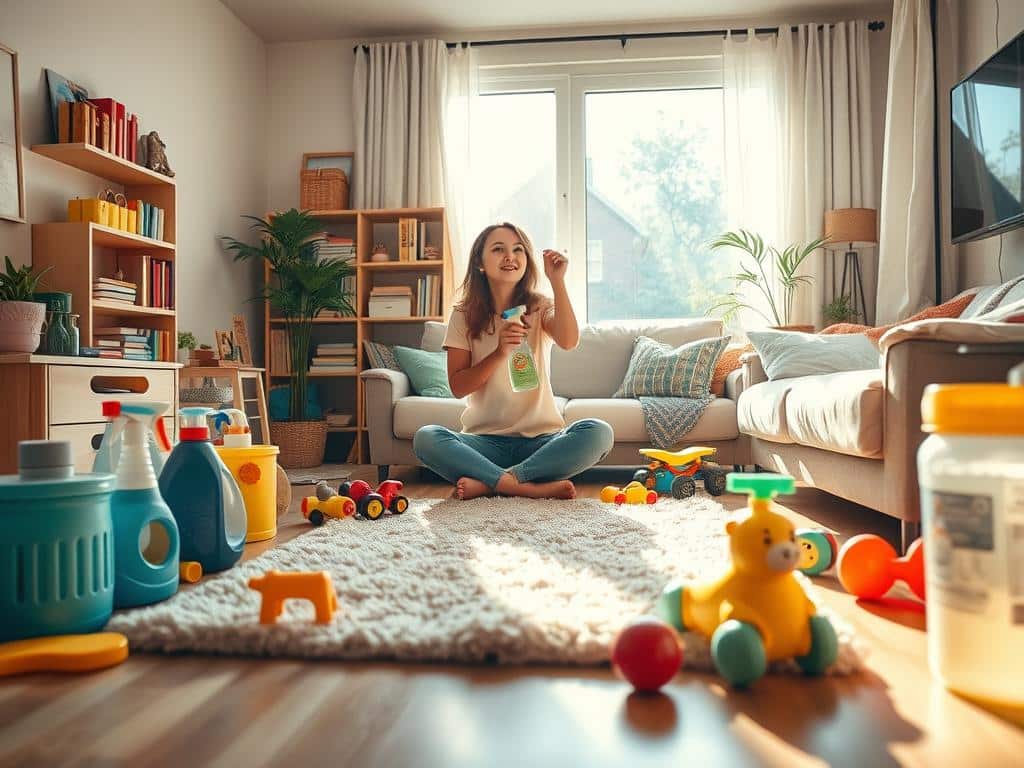
Keeping a clean home with kids is hard, but it’s important. Using child-friendly cleaning routines makes it better for them. Studies show that only 28% of parents have their kids help with chores. This could hurt their ability to do things on their own later. Using non-toxic cleaners keeps your family safe and healthy.
Getting kids to help clean teaches them responsibility and life skills. Even two-year-olds can start with easy tasks. This builds independence. Make a cleaning task list for each room and for each child’s age. This way, cleaning becomes easier to manage and less overwhelming for parents.
For tips on safe cleaning, like when getting your air ducts cleaned, visit this useful resource.
Use non-toxic and biodegradable cleaners to prevent poisoning and harmful exposure. Also, store these products safely. Put them in a locked cabinet or on a high shelf to keep kids safe.
Tell your kids why it’s important to be careful with cleaning products. Knowing this helps prevent accidents. Make sure the area is well-ventilated when cleaning. This avoids dangerous fumes and keeps the air healthy.
Using these safe cleaning methods makes your home safer. It also teaches your kids good habits. They’ll be better at household tasks in the future because of it.
Understanding Cleaning Priorities by Age Groups
Cleaning changes as kids grow. It’s key to tailor cleaning plans for different ages. Focusing on the right things for infants, toddlers, and preschoolers keeps them safe and healthy.
Infants: Key Areas to Focus On
For infants, keeping things clean is very important. Focus on cleaning their bedding, toys, and frequently touched surfaces. This helps protect their weak immune systems from getting sick.
Toddlers: Child-Safe Cleaning Practices
Toddlers move around and explore a lot. Use safe cleaning products and keep harmful ones away. Clean the areas where they play the most. This stops germs and keeps toddlers away from dangerous chemicals.
Preschoolers: Teaching Safe Habits
Preschoolers can start helping with cleaning. Teach them to do simple tasks like putting away toys. This teaches cleanliness, responsibility, and helps with their development. It prepares them for household contributions.
- Ages 5-6: Tasks like making their bed and picking up toys.
- Ages 7-9: They can help prepare meals and handle some money.
- Ages 10-12: They can cook simple meals under supervision and take care of pets.
- Ages 13-14: They can do laundry and cook meals on their own.
Adapting cleaning strategies for each age group keeps your home clean and teaches kids responsibility. Safe practices and suitable tasks make for a healthy, engaging environment as kids grow.
| Age Group | Focus | Key Activities |
|---|---|---|
| Infants | Hygiene | Sanitizing toys, cleaning bedding |
| Toddlers | Safety | Using non-toxic cleaners, cleaning play areas |
| Preschoolers | Habit Formation | Teaching chores, wiping surfaces |
Choosing Non-Toxic Cleaning Products
In today’s world, it’s important to choose non-toxic cleaning products, especially for houses with kids. Regular cleaners can release bad chemicals. These affect the air inside and can harm our breathing. Kids and babies, who stay indoors a lot, are at higher risk. By choosing safer cleaning options, you protect your family’s health.
Why Non-Toxic Ingredients Matter
Some chemicals, like formaldehyde and triclosan, can cause major health issues. Formaldehyde, found in air fresheners, can cause cancer. Triclosan, in antibacterial products, messes with hormones and can make antibiotics less effective. With about 62 toxic chemicals in most homes, picking safe products is key. This move will lower health risks and create a safer home.
Effective Green Cleaning Solutions
Green cleaning products work well and come from simple, natural stuff. The Blueland Clean Essentials Kit is popular and safe. Thrive Market offers affordable eco-friendly items with a $12/month start. Since indoor air can be more polluted than outside, green products are important. Products from Attitude and Cleancult are good choices. They are cheap and green.
How to Make DIY Safe Cleaners
- All-Purpose Cleaner: Mix water and white vinegar. This mix cleans surfaces and fights dirt well.
- Natural Deodorizer: Use baking soda on fabrics to get rid of smells naturally.
- Antimicrobial Disinfectant: Mix lemon juice with water. Lemons kill germs on surfaces.
Making your own cleaners keeps harmful chemicals away from your family. It’s important to understand what’s truly eco-friendly. Making cleaners lets parents know exactly what’s in them, ensuring safety. Using these natural ways leads to a healthier, toxic-free home. This supports a sustainable way of living.
Safe Cleaning for Kids
Safe cleaning in homes with kids needs more than just picking the right cleaners. It also means safely storing and using cleaning products. And, it’s about making kid-friendly cleaning habits.
Safe Storage and Usage of Cleaning Products
Keeping cleaning supplies away from kids is key to a safe home. Harmful chemicals, like ammonia and chlorine, are in many cleaners. These can cause serious harm. These ingredients are dangerous and accidents with them are too common.
Always watch when using these products. After, make sure they are locked up tight. Brands like Seventh Generation, Mrs. Meyers, and Method are safer choices. Dapple’s products are good too, as they avoid harmful additives. These safer options are better for your kids and your home.
Child-Friendly Cleaning Routines
Kids do well with regular chores. Adding simple tasks, like putting toys away or helping to sweep, teaches them important skills. These activities make them feel responsible and keep things clean.
You can also use DIY cleaners. Use things like borax, white vinegar, and essential oils. These ingredients make safe and effective cleaning solutions. There are many recipes for homemade cleaners that are great for families.
With careful selection and use of cleaning products, your home becomes safer for your kids. It’s a place where they can be safe from harmful chemicals. Start these practices now for a healthier home.
Safe Ways for Kids to Help with Chores
Teaching kids early about cleaning tasks is key to good habits later on. Getting kids involved in chores builds responsibility and independence. Picking tasks that match their skills makes sure they can help out safely and well. This not only teaches them important skills but also gives them a sense of pride.
Age-Appropriate Cleaning Tasks
It’s best to pick chores that are right for a child’s age and skills. Young kids can do easy chores like picking up toys, matching socks, or making their bed. As they get older, they can take on more tasks. These might include organizing stuff, dusting, or helping with meals. Such chores make them feel proud of keeping their home clean.
Creating a Fun Cleaning Environment
Making chores fun can make kids more eager to help out. Using games, like competitions or challenges, can help them finish tasks. Rewards such as stickers or extra playtime can motivate them too. The main idea is to keep things positive and make cleaning fun. This approach can keep them interested in helping out over time.
Benefits of Involving Kids in Cleaning
Having kids help with chores is about more than just getting tasks done. Research, like Marty Rossman’s from the University of Minnesota, shows these kids do better in college and at work. Helping with chores can boost their self-confidence, improve their life skills, and strengthen family bonds. It teaches them a strong work ethic and makes them feel part of the family.
| Chore Level | Suggested Age | Examples of Tasks |
|---|---|---|
| Basic Tasks | 2-3 years | Picking up toys, matching socks |
| Intermediate Tasks | 4-6 years | Making their bed, dusting, setting the table |
| Advanced Tasks | 7-10 years | Assisting with meal prep, organizing belongings |
| Complex Tasks | 11+ years | Cleaning bathrooms, mopping floors |
Effective Stain Removal for Common Kid Messes
Kids excel in making a variety of messes, such as food spills and art mishaps. About 78% of homes with kids face stains each week. For 62% of parents, removing these stains is a big laundry issue.
Dealing with Food Spills
The kitchen often sees battles against tough stains. Spills from foods like marinara sauce or ice cream demand quick action. Pre-treating the stain right away boosts success. An experiment showed Method beats Shout in removing stains from cotton T-shirts.
| Food Stain | Effective Removal Method |
|---|---|
| Marinara Sauce | Pre-treat with Method, followed by washing with detergent and OxiClean |
| Nutella | Direct application of Method, then wash |
| Wine | Soak with Method and wash promptly |
Removing Paint and Marker Stains
Don’t worry about messes from your child’s art. Most schools use washable markers which are simple to clean. Yet, permanent markers and ballpoint ink are harder to deal with. Paints like tempera are common in schools but latex paint is tougher once dry. For paints, soaking in diluted white vinegar and scrubbing gently works well.
Cleaning Mud and Grass Stains
Playing outside often brings mud and grass stains. For these tough stains, pre-treating and enzyme cleaners work best. A mix of diluted white vinegar can help with grass stains. Also, 85% of parents like products made for kids’ stains. This shows the need for specific cleaning solutions.
Learn these stain removal tricks and act fast. Doing so helps you keep your home clean, no matter what mess your child makes.
Maintaining a Clean Home with Pets and Kids
Having kids and pets makes keeping a clean home a bit tough. You need a good plan to handle household clutter or achieve cleanliness. About 67% of U.S. homes have a pet, leading to fur, toys everywhere, and accidents.
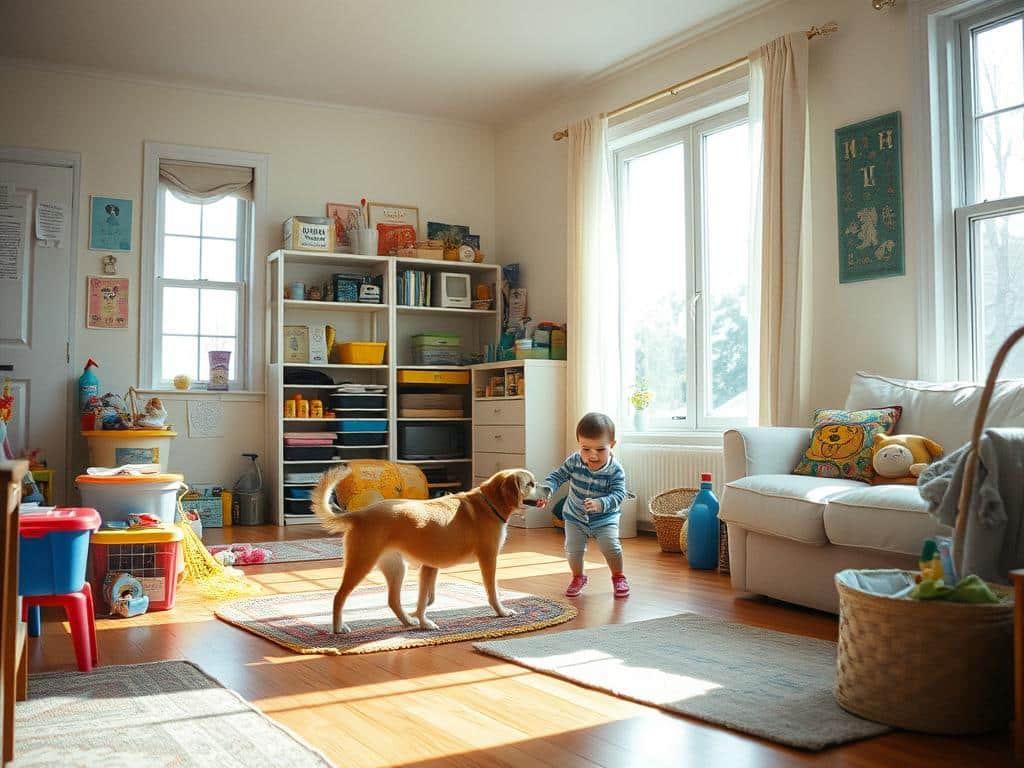
Pet-friendly cleaning means dusting, vacuuming, and mopping often. Pet owners clean about 14.6 hours a week. To manage paw prints and spills, vacuum several times a week. Also, clean pet beds and toys weekly to help control smells.
To keep clutter low with kids, get them to help clean. Give older kids chores that fit their age. Talking with your partner about who cleans what can make things easier. It makes for a happier home.
Choosing the right cleaning products is crucial for families. You should use non-toxic cleaners that can handle stains but are safe for kids and pets. Over half of pet owners choose natural or homemade cleaners, caring about safety.
- Vacuuming multiple times weekly
- Washing pet bedding and toys weekly
- Assigning age-appropriate chores to children
- Opting for non-toxic cleaning products
- Communicating cleaning responsibilities with partners
- Considering hiring a housekeeper for extra support
Clean small messes right away to stop them from getting worse. Using rugs for inside and outside can cut down dirt and allergens from pets by 80%.
| Preventive Measure | Effectiveness |
|---|---|
| Indoor-Outdoor Rugs | Reduce 80% of dirt and allergens |
| Throw Blankets on Furniture | Used by 72% of pet owners to protect furniture |
Staying consistent and using the best tools make it easier to keep your home tidy, even with pets and kids. Following these steps will create a cozy and happy place for your family.
Conclusion
Making a home clean and safe for your family takes a lot of work. Kids and pets make it even tougher. This guide shows how to keep your home clean, even with a busy household. We’ll show how to get everyone involved and teach safe cleaning habits.
It’s important to pick safe cleaning products. Stay away from those labeled DANGER or CORROSIVE. Check with a child care nurse or licensing agency before using alternatives to bleach for disinfecting. And always follow the instructions on EPA-approved products.
Dealing with kid-related messes, like food spills and paint, helps keep the peace. Getting kids to help with cleaning teaches important lessons. It also helps keep your home organized and clean.
In the end, a clean home is more than just looking good. It’s about making a healthy space where your family can grow. With the right strategies, you create not just a tidy space. You build a home filled with care, teamwork, and love. This guide helps tackle the cleaning challenges of a lively household. It aims for a balanced life without stress.

